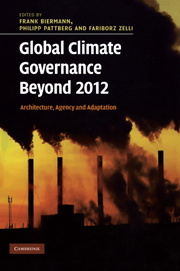Book contents
- Frontmatter
- Contents
- List of contributors
- Preface
- List of abbreviations
- 1 Global climate governance beyond 2012
- Part I Architecture
- 2 The architecture of global climate governance
- 3 The consequences of a fragmented climate governance architecture
- 4 Environmental effectiveness and economic consequences of fragmented versus universal regimes
- 5 Developing the international carbon market beyond 2012
- 6 The overlap between the UN climate regime and the World Trade Organization
- 7 An architecture for long-term climate change
- 8 Shaping the architecture of future climate governance
- Part II Agency
- Part III Adaptation
- Index
- References
2 - The architecture of global climate governance
setting the stage
Published online by Cambridge University Press: 05 July 2014
- Frontmatter
- Contents
- List of contributors
- Preface
- List of abbreviations
- 1 Global climate governance beyond 2012
- Part I Architecture
- 2 The architecture of global climate governance
- 3 The consequences of a fragmented climate governance architecture
- 4 Environmental effectiveness and economic consequences of fragmented versus universal regimes
- 5 Developing the international carbon market beyond 2012
- 6 The overlap between the UN climate regime and the World Trade Organization
- 7 An architecture for long-term climate change
- 8 Shaping the architecture of future climate governance
- Part II Agency
- Part III Adaptation
- Index
- References
Summary
Introduction
This chapter introduces the first main part of this volume, on the overarching ‘architecture’ of global climate governance beyond 2012. In particular, the central question that guides all chapters in this part is about the causes and consequences of fragmentation versus integration of governance architectures. We ask which type of governance architectures promises a higher degree of institutional performance in terms of social and environmental effectiveness, and in particular whether a well-integrated governance architecture is likely to be more effective than a fragmented governance architecture. This question of increasing fragmentation of systems of global governance and of its relative benefits and problems has become a major source of concern for observers and policy-makers alike. Yet there is little consensus in the academic literature on this issue: in different strands of academic research, we find different predictions that range from a positive, affirmative assessment of fragmentation to a rather negative one (Zelli et al., this volume, Chapter 3).
A key example is global climate governance, where advantages and disadvantages of a fragmented governance architecture have become important elements in proposals and strategies for future institutional development. Several proposals for a future climate governance architecture have been put forward that explicitly assert the value of fragmentation or diversity, or at least implicitly accept it. Others, however, remain supportive of a more integrated overall architecture. And yet, political science lacks a conceptual framework for the comparative study of different types and degrees of fragmentation of global governance architectures.
- Type
- Chapter
- Information
- Global Climate Governance Beyond 2012Architecture, Agency and Adaptation, pp. 15 - 24Publisher: Cambridge University PressPrint publication year: 2010
References
- 5
- Cited by



